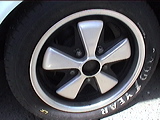
Since the introduction of the modern steel belted radial tire, automotive tires can now safely last upwards to 80,000 miles. Most automotive manufacturers recommend that tires be in service no longer than 6 years on the vehicle, and no longer than 10 years from the date of manufacture. DOT Number — Mandated by the federal government, every tire has a Department of Transportation number.
Up until 1999, the last 3 digits (and from 2000 on, the last 4 digits) of the DOT number describes the week and year the tire was manufactured. For example, tires manufactured in 1999 and earlier with a DOT number ending in 299 would mean the tire was manufactured in the 29th week of 1989 or 1999. From 2000 on, a tire manufactured in the 29th week of 2009 would have 2909.
In all actuality, the amount of rubber that touches the road, also known as the contact patch, is only approximately a 3” x 8” rectangular section. Contrary to popular belief, when a car is moving, the weight of the car is not what is keeping the tires on the road. It is fundamentally the job of the shock absorbers and stabilizer bars during lateral loads (cornering).
After installing new tires, make sure to drive easy for the first 500 miles (reduced lateral and longitudinal loads, and definitely no sporting events). To facilitate removal of the tire from its original mold, tire manufacturers have utilized an internal release agent that will secrete for approximately 500 miles. This release agent will cause the tires to be very slippery when they are new, which can lead to a dangerous situation under certain conditions. Tires are the softest when they are new, and will wear at an accelerated rate until multiple heat cycles have taken place.
Wear indicators — All tires have an external built-in tread wear indicator, also known as the “wear bar.” These help you determine when the tire is near or at its wear limit. These wear indicators are between the treads at multiple points on the tire at a height of 2/32″. When the tire wear reaches the wear indicator anywhere on the tire, the tread is down to 2/32″ and the tire needs to be replaced. Tires should be replaced in pairs and per axle. Most high performance auto manufacturers usually recommend replacing all four tires at the same time.
Nitrogen — Filling your tires with nitrogen is beneficial, but not a necessity. Nitrogen molecules are larger that the oxygen/nitrogen molecules that make up the air that surrounds us. Thus, nitrogen will leak out at a much slower rate (this normal tire leakage is known as “dispersion”). Nitrogen also has much less moisture and will have a linear (flatter) pressure differential between cold and hot temperatures.
Please note, if your tire pressure falls as little as 4-5psi below Porsche’s recommended tire inflation, tire wear can be accelerated by as much as 25%. It is generally recommended that the tire pressures be checked at least once a month using a good quality tire pressure gauge.
Rotations — Tire rotation (if your car allows) is generally recommended twice a year. Wheel alignment — It is preferred to have a 4-wheel alignment performed every time new tires are installed, once a year, or if there was a substantial impact to the wheel or tire (a large pot hole or a curb, etc.).
Tiptronic transmission shifting issues can be created or exaggerated by mismatched rear tires or incorrect tire pressures. This should be first on the diagnosis list when any Tiptronic transmission shifting issue exists.
Tony Callas & Tom Prine